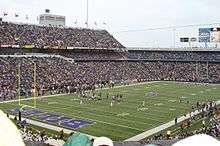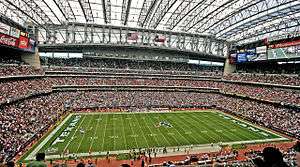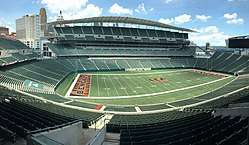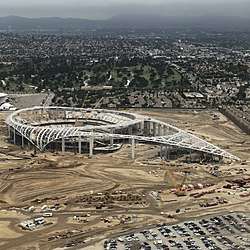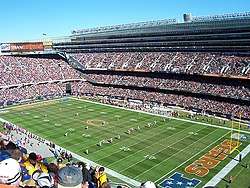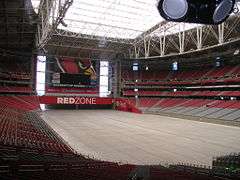List of current National Football League stadiums
This article is a list of current National Football League stadiums, sorted by capacity, their locations, their first year of usage, and home teams. Although the National Football League (NFL) has 32 teams, there are only 30 full-time NFL stadiums because the New York Giants and New York Jets share MetLife Stadium, and the Los Angeles Rams and the Los Angeles Chargers share SoFi Stadium.


The newest full-time NFL stadiums are SoFi Stadium in Inglewood, California, home of the Los Angeles Rams and the Los Angeles Chargers, and Allegiant Stadium in Las Vegas, home of the Las Vegas Raiders, which will both open for the 2020 season. Soldier Field in Chicago is the oldest, having opened in 1924.
The NFL uses several other stadiums on a regular basis in addition to the teams' designated regular home sites. In England, two London venues—Tottenham Hotspur Stadium and Wembley Stadium—are contracted to host a combined four games per season, as part of the NFL International Series which runs through 2020. Estadio Azteca in Mexico City hosted NFL International Series games in 2016, 2017, and 2019, and is under contract to host one game per season through 2021. In addition, Tom Benson Hall of Fame Stadium in Canton, Ohio, is the location of the annual exhibition Pro Football Hall of Fame Game. Since 2016, Camping World Stadium in Orlando, Florida has hosted the Pro Bowl.
The majority of current NFL stadiums have sold naming rights to corporations. As of the upcoming 2020 season, only four of the league's 30 stadiums—Arrowhead Stadium, Lambeau Field, Paul Brown Stadium, and Soldier Field—do not use a corporate-sponsored name.
Stadium characteristics
Stadiums represent a considerable expense to a community, and thus their construction, use, and funding often enter the public discourse.[1] Also, given the perceived advantage a team gets to playing in its home stadium, particular attention is given in the media to the peculiarities of each stadium's environment. Climate, playing surface (either natural or artificial turf), and the type of roof all contribute to giving each team its home-field advantage.
Stadiums are either open, enclosed, or have a retractable roof. For retractable roofs, the home team determines if the roof is to be opened or closed 90 minutes before kickoff. The roof remains open unless precipitation or lightning is within the vicinity of the stadium, the temperature drops below 40 °F (4 °C), or wind gusts are greater than 40 miles per hour (64 km/h), in which case the roof operators will close the roof.[2]
Seating
With a peak capacity of over 100,000 spectators, AT&T Stadium has the highest capacity of any NFL stadium, while MetLife Stadium has the highest listed seating capacity at 82,500. The smallest stadium is Soldier Field with a capacity of 61,500.
In their normal configurations, all of the league's 30 stadiums have a seating capacity of at least 60,000 spectators; of those, a majority (17) have fewer than 70,000 seats, while eight have between 70,000 and 80,000 and five can seat 80,000 or more. In contrast to college football stadiums, the largest of which can and regularly do accommodate over 100,000 spectators, no stadium in the league currently has a listed seating capacity of more than 82,500. Teams rarely build their stadiums far beyond the 80,000 seat threshold (and even then, only in the largest markets) because of the league's blackout policy, which prohibited the televising of any NFL game within 75 miles of its home market if a game does not sell all of its non-premium seating. The policy was suspended from 2015–2019 while several teams were playing in temporary facilities with capacities far larger than a normal stadium. It is unclear if this suspension will continue into 2020. In the opposite direction, the league has a firm minimum on the number of seats an NFL stadium should have; since 1971 the league has not allowed any stadium under 50,000 seats to host a full-time NFL team. In normal circumstances, all NFL stadiums are all-seaters.
Legend
List of current stadiums
Some stadiums can be expanded to fit larger crowds for other events such as concerts or conventions. Official seating capacities do not include standing room.
Map of current stadiums
Field
Stadium
Additional stadiums
| Image | Stadium | Capacity | Location | Surface | Roof type | Event(s) | Opened | Ref(s) |
|---|---|---|---|---|---|---|---|---|
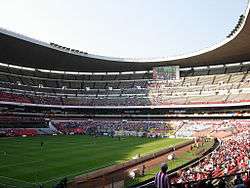 |
Estadio Azteca | 87,523[42] | Mexico City, Mexico | Grass | Open | NFL Mexico Game | 1966 | |
 |
Tom Benson Hall of Fame Stadium | 22,364 | Canton, Ohio | FieldTurf Classic HD | Open | Hall of Fame Game | 1938[nb 2] | [43] |
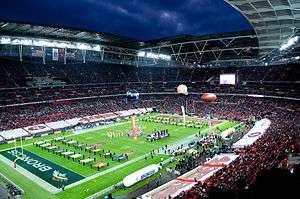 |
Wembley Stadium |
86,000[nb 3] | London, England | Desso GrassMaster | Partially retractable | NFL London Games | 2007 | |
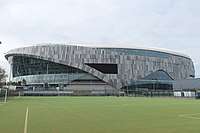 |
Tottenham Hotspur Stadium | 62,062 | London, England | Artificial turf | Open | NFL London Games | 2019 | [44] |
Future stadiums
| Stadium | Capacity | Location | Surface | Roof type | Team(s) | Opening | Ref(s) |
|---|---|---|---|---|---|---|---|
| New Era Field II | Buffalo, New York | Grass | Open | Buffalo Bills | |||
| Redskins Stadium | 60,000 | Open | Washington Redskins |
See also
- Chronology of home stadiums for current National Football League teams
- National Football League
- Stadiums to host the Super Bowl (including future years)
- List of NCAA Division I FBS football stadiums
- List of NCAA Division I FCS football stadiums
- List of American football stadiums by capacity
- List of U.S. stadiums by capacity
- List of North American stadiums by capacity
- List of Canadian Football League stadiums
- List of current Major League Baseball stadiums
- List of Major League Soccer stadiums
- List of Major League Lacrosse stadiums
- List of National Basketball Association arenas
- List of National Hockey League arenas
Notes
- Soldier Field opened in 1924; Bears became tenants in 1971; playing field and seating bowl renovated in 2003.
- Tom Benson Hall of Fame Stadium opened as Fawcett Stadium in 1938; rebuilt in 2015–2016.
- Wembley Stadium seating reduced from 90,000 for NFL games
References
- "In a league of its own". The Economist. April 27, 2006. Retrieved August 19, 2016.
- "Adopted Playing Rules Change Proposals, Resolutions & Bylaws" (PDF). NFL Communications. March 25, 2015. Retrieved August 7, 2015.
- "Las Vegas stadium proposal details revealed: Raiders get naming rights, one dollar rent, pick preferred site, more". Silver And Black Pride. Retrieved September 7, 2017.
- "Homes of the Chiefs" (PDF). 2016 Kansas City Chiefs Media Guide. Kansas City Chiefs. August 15, 2016. Retrieved August 19, 2016.
- "Dallas Cowboys Team Capsule" (PDF). 2016 Official National Football League Record and Fact Book. National Football League. July 15, 2016. Retrieved August 19, 2016.
- "Fingertip Information" (PDF). 2015 Dallas Cowboys Media Guide. Dallas Cowboys. August 28, 2015. Retrieved August 19, 2016.
- "Stadium Facts Overview". Carolina Panthers. August 7, 2015. Retrieved August 7, 2015.
- "Featured Projects - FieldTurf". fieldturf.com. Retrieved 2018-11-03.
- "Stadium Facts - CenturyLink Field". CenturyLink Field. August 7, 2015. Retrieved August 7, 2015.
- "Facts - Figures – Sports Authority Field at Mile High". Denver Broncos. August 6, 2015. Retrieved August 6, 2015.
- "FedExField" (PDF). 2015 Washington Redskins Media Guide. Washington Redskins. August 28, 2015. Retrieved August 19, 2016.
- "Cleveland Browns Team Capsule" (PDF). 2016 Official National Football League Record and Fact Book. National Football League. July 15, 2016. Retrieved August 19, 2016.
- "About Us". FirstEnergy Stadium. 2017. Retrieved July 6, 2017.
- "Ford Field Facts & History". Detroit Lions. August 7, 2015. Archived from the original on September 5, 2015. Retrieved August 7, 2015.
- "Gillette Stadium - Venue Information". Gillette Stadium. Retrieved August 19, 2016.
- "FAQs". Hard Rock Stadium. Archived from the original on September 22, 2016. Retrieved August 19, 2016.
What is capacity in the new Stadium? The capacity is being reduced from 76,018 to approximately 65,326 seats.
- "Heinz Field Facts". Heinz Field. August 7, 2015. Retrieved August 7, 2015.
- Silverstein, Tom. "Lambeau surface kept safe and soft through technology". jsonline.com. Milwaukee Journal-Sentinel. Retrieved December 15, 2015.
- "2015 Green Bay Packers Media Guide". Green Bay Packers. August 4, 2015. Archived from the original on July 6, 2016. Retrieved November 18, 2015.
- "About - Levi's® Stadium". Levi’s® Stadium. August 7, 2015. Retrieved August 7, 2015.
- Frank, Reuben (October 24, 2013). "Linc's structure, playing surface a bigger problem than family-friendly atmosphere". NBC Sports Philadelphia.
- "Lincoln Financial Field" (PDF). 2016 Philadelphia Eagles Media Guide. Philadelphia Eagles. July 19, 2016. Archived from the original (PDF) on August 28, 2016. Retrieved August 19, 2016.
- "About". Lucas Oil Stadium. Archived from the original on March 6, 2019. Retrieved August 19, 2016.
- "M&T Stadium". Baltimore Ravens. August 7, 2015. Retrieved August 7, 2015.
- "Mercedes-Benz Stadium Will Have FieldTurf". Archived from the original on April 6, 2017. Retrieved April 16, 2017.
- "Fast Facts". Mercedes-Benz Stadium. Retrieved August 19, 2016.
- "A-Z Guide". Mercedes-Benz Superdome. Retrieved August 19, 2016.
- Bradley, Bill. "NFL Turf Gurus Start Preparing MetLife Field for Super Bowl XLVIII". nfl.com. National Football League. Retrieved December 15, 2015.
- "MetLife Stadium". MetLife Stadium. August 6, 2015. Retrieved August 6, 2015.
- Baker, Kelly (August 18, 2016). "A look through history of the home of the Buffalo Bills". Buffalo Bills. Archived from the original on August 21, 2016. Retrieved August 22, 2016.
- "Titans Fingertip Information" (PDF). 2016 Tennessee Titans Media Guide. Tennessee Titans. July 21, 2016. Retrieved August 19, 2016.
- "Hellas Installs Turf at NRG Stadium, Named Texans' Preferred Turf Provider". Retrieved August 1, 2018.
- "NRG Stadium". NRG Park. August 7, 2015. Retrieved August 7, 2015.
- "Facts and Stats". Cincinnati Bengals. August 7, 2015. Archived from the original on August 30, 2015. Retrieved August 7, 2015.
- "Frequently Asked Questions". Raymond James Stadium. August 7, 2015. Retrieved August 7, 2015.
- Velotta, Rick (18 September 2017). "Construction activity begins at Las Vegas Raiders stadium site – VIDEO". Las Vegas Review-Journal. Retrieved 2 January 2020.
- "Chicago Bears Media Guide" (PDF). Chicago Bears. August 22, 2014. Retrieved August 7, 2015.
- "History - University of Phoenix Stadium". University of Phoenix Stadium. Archived from the original on August 20, 2015. Retrieved August 7, 2015.
- O'Hallaran, Ryan (February 12, 2018). "Jaguars announce tarp removal, 2018 season-ticket renewal plan". Florida Times-Union. Retrieved June 15, 2018.
- Peters, Craig. "9 Things to Know about Vikings New Turf at U.S. Bank Stadium". vikings.com. Minnesota Vikings. Archived from the original on May 17, 2016. Retrieved May 10, 2016.
- "Stadiums by the Numbers". Minnesota Vikings. Archived from the original on February 14, 2017. Retrieved August 19, 2016.
- "2026 FIFA World Cup Bid Book" (PDF). p. 161. Retrieved 5 April 2018.
- "Tom Benson Hall of Fame Stadium". Pro Football Hall of Fame. November 24, 2014. Archived from the original on November 28, 2014. Retrieved August 19, 2016.
- "New Stadium". Tottenham Hotspur. Archived from the original on November 5, 2015. Retrieved October 26, 2015.

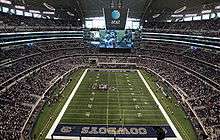
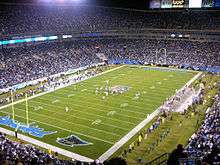

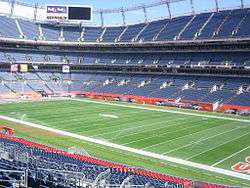


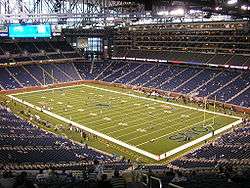
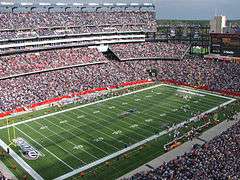
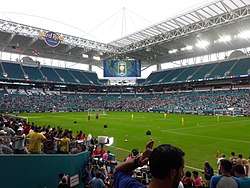

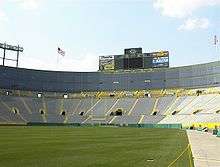
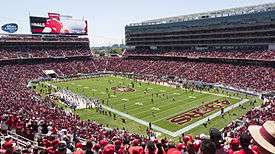

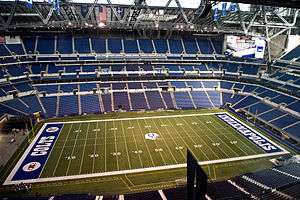
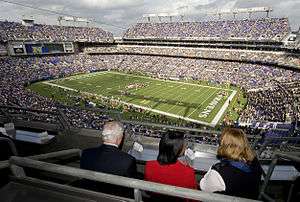
.jpg)
.jpg)

